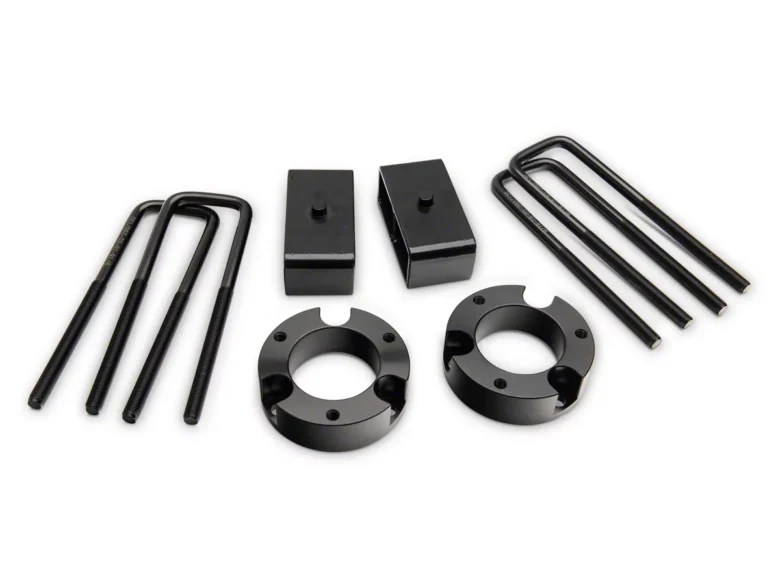Leveling kits have gained immense popularity when it comes to enhancing the appearance and performance of your truck or SUV. These kits provide an affordable and effective solution to balance your vehicle’s stance, creating a more even height between the front and rear. In this comprehensive guide, we’ll dive into the world of KSP leveling kits, discussing their benefits, types, installation process, and the key factors to consider before making a purchase decision.
Benefits of Leveling Kits
Leveling kits offer a range of benefits that can significantly improve both the aesthetics and performance of your vehicle:
- Enhanced Appearance: One of the primary reasons enthusiasts opt for 2 inch leveling kits is to achieve a more aggressive and balanced stance. By leveling the front and rear of your vehicle, you eliminate the “nose-down” factory rake, giving your ride a more imposing and uniform look.
- Improved Ground Clearance: Leveling kits provide a slight increase in ground clearance, allowing you to navigate rough terrains, speed bumps, and obstacles more comfortably. This is especially beneficial for off-road enthusiasts.
- Enhanced Towing and Hauling: Leveling your vehicle helps maintain a level alignment, which can enhance towing and hauling capabilities. This can lead to improved stability and control while towing heavy loads.
- Tire and Wheel Options: Leveling kits often create more space in the wheel wells, allowing for larger tires and wheels. This not only adds to the visual appeal but also enhances off-road performance.
Installation Process
While some vehicle enthusiasts opt to install 3 inch leveling kits themselves, having them professionally installed is recommended to ensure proper alignment and safety. The process generally involves:
- Preparation: Ensure you have all the necessary tools, equipment, and safety gear before installing.
- Lifting the Vehicle: The vehicle is raised using a jack and securely placed on jack stands.
- Front Suspension: The front suspension components are disassembled for strut extension kits, and the spacers are added to achieve the desired lift.
- Rear Suspension: If required, rear suspension components are adjusted to achieve the desired height balance.
- Alignment Check: After the installation, it’s crucial to perform a wheel alignment to ensure that the vehicle’s handling and tire wear are not negatively affected.

Key Factors to Consider
Before investing in a leveling kit, consider the following factors:
- Compatibility: Ensure that the leveling kit is designed for your specific vehicle make and model.
- Quality: Opt for reputable brands that produce high-quality leveling kits to ensure durability and performance.
- Ride Comfort: Significant vehicle suspension alterations can impact ride comfort. Research user reviews and consult professionals for advice.
- Warranty: Check if the leveling kit has a contract, as this can provide you with added peace of mind.
Do leveling kits affect alignment?
Leveling kits can indeed affect your vehicle’s alignment, but the extent to which they do depends on the specific type of leveling kit and how it’s installed.
Leveling kits are commonly used to raise the front or rear of a vehicle to achieve a more even stance, especially in trucks and SUVs where the front end can be lower due to factors like heavy engines or equipment. There are several types of leveling kits:
- Strut Extension Kits: These involve adding spacers or extensions to the front struts or coil springs to lift the front of the vehicle. Since these kits modify the suspension components, they can impact the alignment angles.
- Block or Add-a-Leaf Kits: These kits raise the vehicle’s rear by adding blocks or extra leaves to the suspension system. They are generally less likely to affect alignment since they don’t directly modify the front suspension components.
Other Details
When a leveling kit is installed, it can change the alignment angles, such as camber, caster, and toe. Here’s how:
- Camber: It refers to the tilt of the wheels relative to the vertical axis. Changes in camber can affect tire wear, stability, and handling. If a leveling kit alters the suspension geometry significantly, it can lead to camber changes.
- Caster: The caster angle affects steering stability and the return-to-center feel of the steering wheel. Significant modifications to the front suspension might alter the caster angle, impacting how the vehicle handles.
- Toe: Toe angle is the angle at which the tires point in or out when viewed from above. Improper toe settings can cause uneven tire wear and affect steering responsiveness. Installing a leveling kit can influence toe settings.
To mitigate the alignment effects of a leveling kit, it’s recommended to have a professional alignment done after the equipment is installed. An experienced mechanic can adjust the alignment angles to ensure they are within the manufacturer’s specifications. It might also be a good idea to consult with a professional before choosing a leveling kit to understand how it might affect your vehicle’s alignment and overall performance.
Conclusion
Leveling kits are a popular aftermarket accessory that can transform the stance and performance of your truck or SUV. By achieving a balanced stance, enhancing ground clearance, and providing opportunities for larger tires, these kits offer a range of benefits for both racing and off-road enthusiasts. Before making a purchase, carefully consider the type of leveling kit, the installation process, and the factors that matter most to you, ensuring that you make an informed decision that suits your vehicle and driving preferences.



